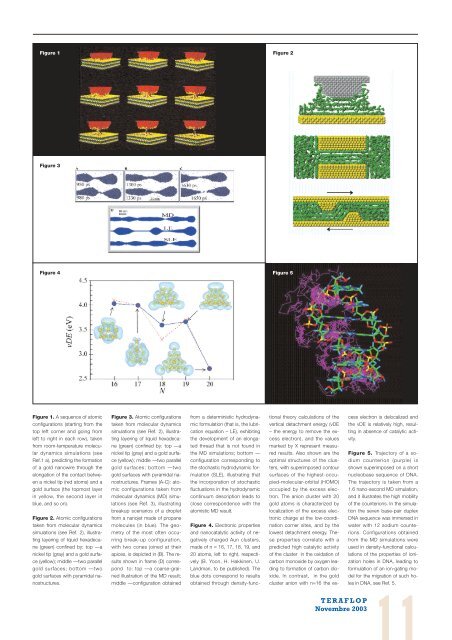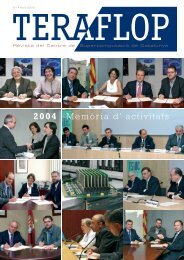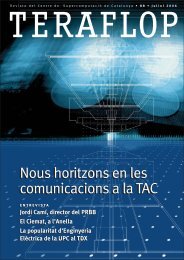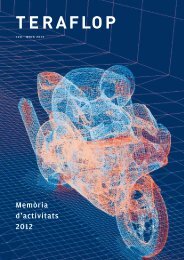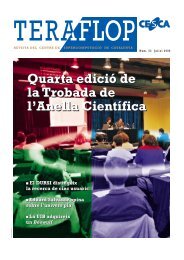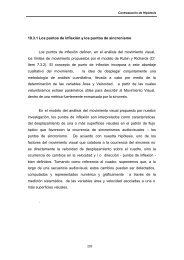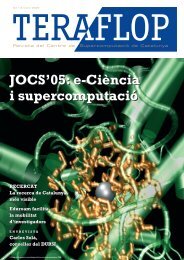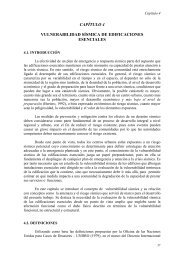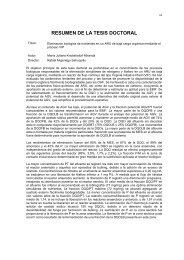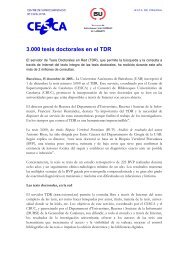Teraflop 73 - Novembre - cesca
Teraflop 73 - Novembre - cesca
Teraflop 73 - Novembre - cesca
You also want an ePaper? Increase the reach of your titles
YUMPU automatically turns print PDFs into web optimized ePapers that Google loves.
Figure 1<br />
Figure 3<br />
Figure 4<br />
Figure 1. A sequence of atomic<br />
configurations (starting from the<br />
top left corner and going from<br />
left to right in each row), taken<br />
from room-temperature molecular<br />
dynamics simulations (see<br />
Ref.1 a), predicting the formation<br />
of a gold nanowire through the<br />
elongation of the contact between<br />
a nickel tip (red atoms) and a<br />
gold surface (the topmost layer<br />
in yellow, the second layer in<br />
blue, and so on).<br />
Figure 2. Atomic configurations<br />
taken from molecular dynamics<br />
simulations (see Ref. 2), illustrating<br />
layering of liquid hexadecane<br />
(green) confined by: top —a<br />
nickel tip (gray) and a gold surface<br />
(yellow); middle —two parallel<br />
gold surfaces; bottom —two<br />
gold surfaces with pyramidal nanostructures.<br />
Figure 3. Atomic configurations<br />
taken from molecular dynamics<br />
simulations (see Ref. 2), illustrating<br />
layering of liquid hexadecane<br />
(green) confined by: top —a<br />
nickel tip (gray) and a gold surface<br />
(yellow); middle —two parallel<br />
gold surfaces; bottom —two<br />
gold surfaces with pyramidal nanostructures.<br />
Frames (A-C): atomic<br />
configurations taken from<br />
molecular dynamics (MD) simulations<br />
(see Ref. 3), illustrating<br />
breakup scenarios of a droplet<br />
from a nanojet made of propane<br />
molecules (in blue). The geometry<br />
of the most often occurring<br />
break-up configuration,<br />
with two cones joined at their<br />
apices, is depicted in (B). The results<br />
shown in frame (D) correspond<br />
to: top —a coarse-grained<br />
illustration of the MD result;<br />
middle —configuration obtained<br />
from a deterministic hydrodynamic<br />
formulation (that is, the lubrication<br />
equation – LE), exhibiting<br />
the development of an elongated<br />
thread that is not found in<br />
the MD simulations; bottom —<br />
configuration corresponding to<br />
the stochastic hydrodynamic formulation<br />
(SLE), illustrating that<br />
the incorporation of stochastic<br />
fluctuations in the hydrodynamic<br />
continuum description leads to<br />
close correspondence with the<br />
atomistic MD result.<br />
Figure 4. Electronic properties<br />
and nanocatalytic activity of negatively<br />
charged Aun clusters,<br />
made of n = 16, 17, 18, 19, and<br />
20 atoms, left to right, respectively<br />
(B. Yoon, H. Hakkinen, U.<br />
Landman, to be published). The<br />
blue dots correspond to results<br />
obtained through density-func-<br />
Figure 2<br />
Figure 5<br />
tional theory calculations of the<br />
vertical detachment energy (vDE<br />
– the energy to remove the excess<br />
electron), and the values<br />
marked by X represent measured<br />
results. Also shown are the<br />
optimal structures of the clusters,<br />
with superimposed contour<br />
surfaces of the highest-occupied-molecular-orbital<br />
(HOMO)<br />
occupied by the excess electron.<br />
The anion cluster with 20<br />
gold atoms is characterized by<br />
localization of the excess electronic<br />
charge at the low-coordination<br />
corner sites, and by the<br />
lowest detachment energy. These<br />
properties correlate with a<br />
predicted high catalytic activity<br />
of the cluster in the oxidation of<br />
carbon monoxide by oxygen leading<br />
to formation of carbon dioxide.<br />
In contrast, in the gold<br />
cluster anion with n=16 the ex-<br />
TERAFLOP<br />
<strong>Novembre</strong> 2003<br />
cess electron is delocalized and<br />
the vDE is relatively high, resulting<br />
in absence of catalytic activity.<br />
Figure 5. Trajectory of a sodium<br />
counterion (purple) is<br />
shown superimposed on a short<br />
nucleobase sequence of DNA.<br />
The trajectory is taken from a<br />
1.6 nano-second MD simulation,<br />
and it illustrates the high mobility<br />
of the counterions. In the simulation<br />
the seven base-pair duplex<br />
DNA sequence was immersed in<br />
water with 12 sodium counterions.<br />
Configurations obtained<br />
from the MD simulations were<br />
used in density-functional calculations<br />
of the properties of ionization<br />
holes in DNA, leading to<br />
formulation of an ion-gating model<br />
for the migration of such holes<br />
in DNA, see Ref. 5.


